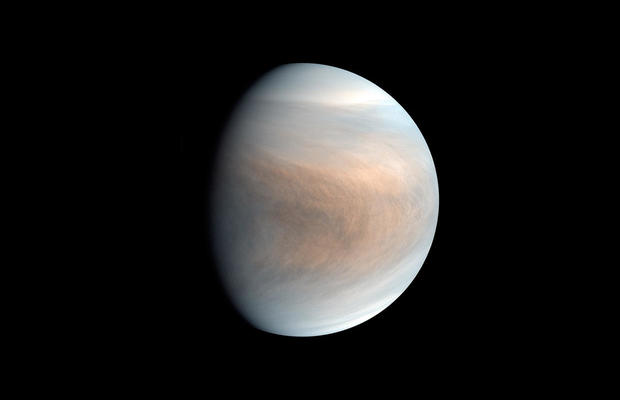Astronomers find possible signs of life on Venus
Venus #Venus

Traces of a rare molecule known as phosphine have been found in the hellish, heavily acidic atmosphere of Venus, astronomers announced Monday — providing a tantalizing clue about the possibility of life. Phosphene molecules found on Earth are primarily a result of human industry or the actions of microbes that thrive in oxygen-free environments.
The researchers are not claiming life has been detected on the second planet from the sun. But the observations suggest at least the possibility of microbial activity in the upper layers of Venus’ atmosphere, well away from the planet’s inhospitable surface.
“There is a chance that we have detected some kind of living organism in the clouds of Venus,” said Jane Greaves, a professor at Cardiff University in the United Kingdom and lead author of a report published in Nature Astronomy.
 A false-color image of Venus as captured by the Ultraviolet Imager aboard Japan’s Venus Climate Orbiter (Akatsuiki). JAXA
A false-color image of Venus as captured by the Ultraviolet Imager aboard Japan’s Venus Climate Orbiter (Akatsuiki). JAXA
Even so, the team said, much more study is needed to support any such claim, extraordinary as it would be.
Mars has long been considered the best candidate in the solar system beyond Earth to have hosted microbial life in the distant past or even in the present, as suggested by background levels of methane. NASA, the European Space Agency, China, India, Russia and United Arab Emirates are all pursuing exploration of the red planet in one form or another.
NASA also is planning a flagship mission to study the moons of Jupiter where scientists believe Europa, heated by tidal stresses and gravitational interactions with other moons, harbors a salty, possibly habitable ocean beneath its icy crust. Other frozen moons in the outer solar system, possible “water worlds,” are also candidates for study.
But Venus is the victim of a runaway greenhouse effect in which thick clouds in a mostly carbon dioxide atmosphere trap sunlight, producing temperatures at the surface that soar to nearly 900 degrees, hot enough to melt lead.
In the planet’s upper atmosphere, however, temperatures are much more hospitable. Despite the acidic nature of the clouds, scientists have speculated it may be possible for alien microbes to exist.
Greaves’ team studied spectra of Venus’ atmosphere using the James Clerk Maxwell Telescope in Hawaii and 45 radio telescope antennas in the Atacama Large Millimeter/submillimeter Array in Chile.
“This was an experiment made out of pure curiosity, really, taking advantage of JCMT’s powerful technology and thinking about future instruments,” Greaves said in a statement. “I thought we’d just be able to rule out extreme scenarios, like the clouds being stuffed full of organisms. When we got the first hints of phosphine in Venus’ spectrum, it was a shock.”
The detection was rewarded with additional observing time on the ALMA array and “in the end, we found that both observatories had seen the same thing, faint absorption at the right wavelength to be phosphine gas, where the molecules are backlit by the warmer clouds below,” Greaves said.
Only trace amounts were observed, about 20 molecules per billion. But additional research showed natural sources of phosphine — volcanoes, lightning, minerals blown up into the atmosphere, the action of sunlight — would only generate one ten thousandth the amount actually detected, according to the statement.
The team can rule out many non-biological ways to generate the observed levels of phosphine, but that doesn’t mean life is the only explanation. The atmosphere of Venus is 90% sulfuric acid, raising “many questions, such as how any organisms could survive,” said MIT researcher Cara Sousa Silva.
“On Earth, some microbes can cope with up to about 5% of acid in their environment, but the clouds of Venus are almost entirely made of acid,” she said.
Greaves’ team is awaiting additional telescope time to look for signs of other gases associated with biological activity and to determine the temperature of the clouds where the phosphine is present to gain additional insights.
“A key question in science is whether life exists beyond Earth, and the discovery by Professor Jane Greaves and her team is a key step forward in that quest,” said Emma Bunce, president of the Royal Astronomical Society. “I’m particularly delighted to see UK scientists leading such an important breakthrough, something that makes a strong case for a return space mission to Venus.”
 Spotting Venus 20 photos
Spotting Venus 20 photos